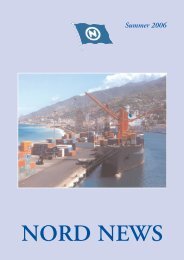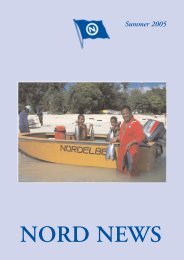Nord news
Nord news
Nord news
You also want an ePaper? Increase the reach of your titles
YUMPU automatically turns print PDFs into web optimized ePapers that Google loves.
4<br />
L<br />
ania, is a charming restored village<br />
just 20 minutes away from the<br />
bustling seaside of Limassol, yet a<br />
world away from modern life.<br />
Like most of the villages in the south<br />
sides of Troodos Mountains, Lania originated in<br />
the feudal times, around 500 to 600 years ago.<br />
The limestone soil of the area around the<br />
village is ideal for the cultivation of grapes with a<br />
very high degree of sugar content. That's what<br />
seems to have attracted Knights and Monks in<br />
the 14th Century to built the first habitations.<br />
Kolossi was the headquarters of a number of<br />
Estates in the region and produced excellent<br />
wines. In their search for a suitable area to<br />
produce even better quality of the<br />
"Commandaria Wine" they moved from Kolossi<br />
and the area around Kolossi castle and built the<br />
first habitations in the Lania area.<br />
This sweet red wine was produced on the<br />
Island from the very early days but actually took<br />
its name from "Grand Commandaria" the<br />
headquarters of the Kingdom. On a map dating<br />
back to 1400 AD the area around the village is<br />
marked as "Nova Lana", clearly connecting the<br />
village with "Lana" the area around Kolossi Castle.<br />
Throughout the centuries Commandaria<br />
NORD NEWS Winter 2006<br />
Lania ... a “ Tra<br />
was produced in the seventeen wineries of the<br />
village. "Linos" is the name of those small family<br />
owned units and you can still see the last one left,<br />
situated in the middle of the village. In these<br />
sophisticated work shops the grapes that were<br />
dried under the sun - were squashed first and<br />
then bundled under the double lever and covered<br />
by heavy, oak presses. Opposite there was a<br />
round shaped rock with a hole in the middle.<br />
This rock was lifted up by turning a spindle so<br />
that the lever is brought down pressing the<br />
grapes. The grape must flowed in an earthenware<br />
jar placed on the ground. The production was<br />
around 200 tons in the 19th century, a huge<br />
quantity considering the population of the<br />
village. Commandaria was always a product for<br />
export and was sold even to France.<br />
The inhabitants of the village are<br />
occupied even these days with the cultivation of<br />
grapes and the existence of this village was always<br />
connected to the production of wine.<br />
Today, Lania is a quiet place with one<br />
hundred or so local residents and almost the<br />
same number of British ex-patriots who enjoy<br />
this beautiful place after their retirement.<br />
Almost all houses have been restored<br />
with stone and wood blending together in<br />
harmony. The restoration of old houses started
















